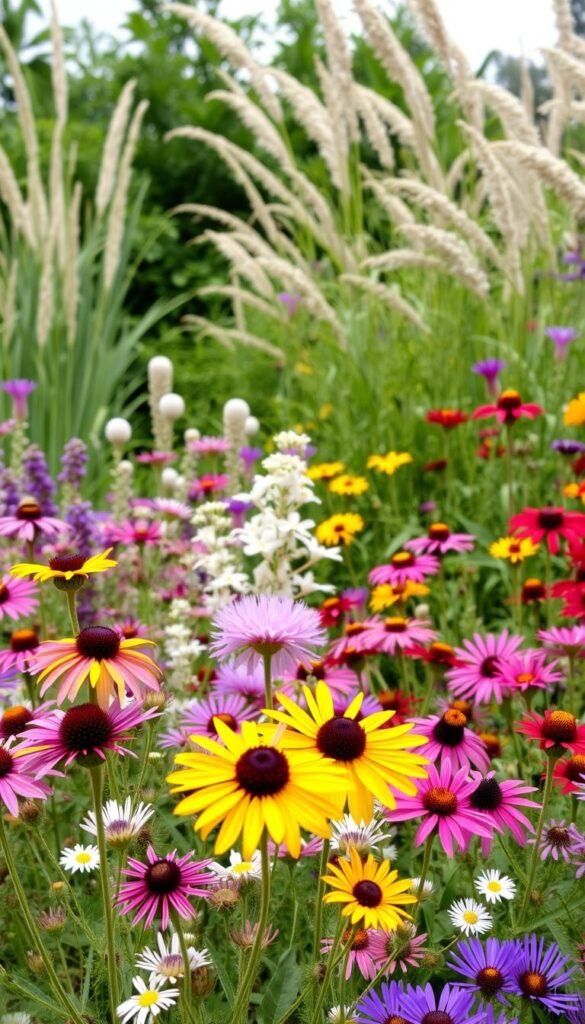Imagine transforming your yard into a vibrant space where colorful blooms dance with butterflies and hummingbirds—all while saving time and resources. Regional plants that evolved in your area’s climate and soil offer the perfect foundation for landscapes requiring minimal upkeep. These hardy varieties naturally resist pests, survive droughts, and flourish without synthetic additives.
By selecting native Colorado wildflowers, you create habitats for bees, birds, and beneficial insects. Their staggered bloom times ensure visual interest from spring through fall, with seed heads providing winter texture. You’ll spend less time watering and weeding compared to conventional gardens, freeing you to enjoy nature’s show.
Did you know? A well-planned layout using diverse heights and colors mimics natural ecosystems. This approach reduces erosion while supporting biodiversity—a win for your property and local wildlife.
Your efforts contribute to preserving regional plant heritage while cutting maintenance costs. As these species establish deep roots, they improve soil health and prevent runoff. The result? A living tapestry that connects your space to surrounding wilderness through every season.
Understanding Your Native Garden: Benefits and Ecological Impact
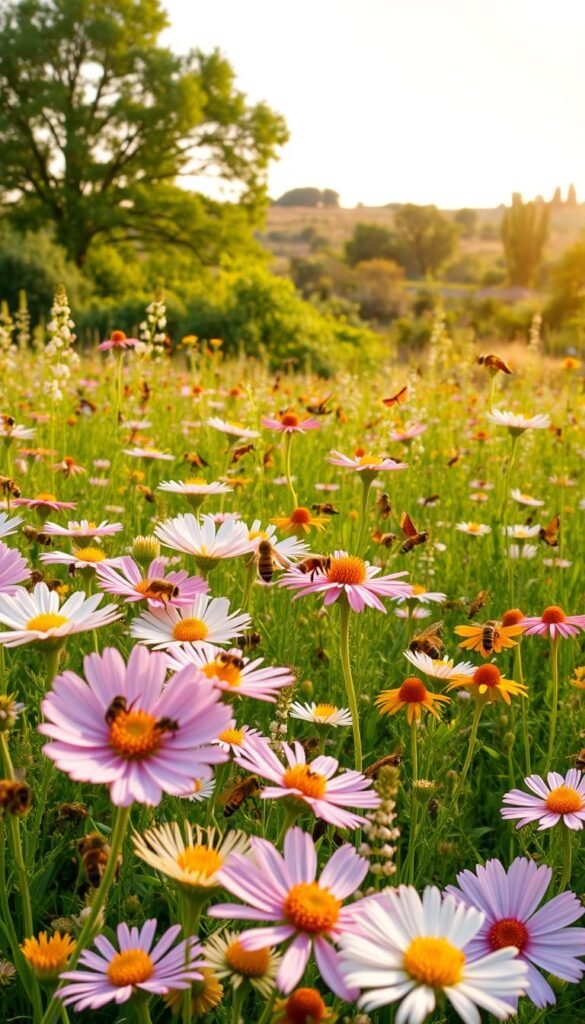
The true power of your outdoor space lies in its ability to sustain life. By cultivating regional plants, you create a thriving habitat for bees, butterflies, and birds that urban areas often lack. These creatures aren’t just visitors—they’re essential partners in maintaining healthy ecosystems.
Your green space becomes a supermarket and nursery rolled into one. Blooming varieties offer nectar for adult pollinators, while leaves host caterpillars and larvae. This cycle supports entire food chains, from insects to songbirds. Fun fact: A single square meter of native vegetation can shelter up to 35 bee species!
Beyond supporting wildlife, these landscapes work overtime below ground. Deep roots enhance soil structure, preventing erosion during heavy rains. They also filter rainwater naturally, reducing runoff pollution in local waterways. You’re essentially growing a living water treatment system.
The benefits extend far beyond your property line. Native plants help sustain regional biodiversity by providing genetic material for nearby wild areas. As your garden matures, it’ll demand less watering and no synthetic chemicals—saving you time while protecting groundwater. Now that’s what we call a win-win ecosystem!
Planning and Preparing Your Wild Flower Garden

Your journey to a thriving natural landscape begins with understanding your land’s unique characteristics. Start by becoming a detective—observe how sunlight moves across your area and where water pools after rain. These clues determine which plants will thrive naturally.
Site Analysis and Soil Testing
Grab a soil test kit from your local extension office. Most flowering varieties prefer slightly acidic to neutral pH (6.0-7.0) and low organic matter. Pro tip: Sandy soils drain quickly, while clay holds moisture—match species to these conditions.
| Soil Type | Sun Exposure | Recommended Varieties |
|---|---|---|
| Dry/Sandy | Full Sun | Prairie Coneflower, Butterfly Weed |
| Moist/Clay | Partial Shade | Cardinal Flower, Blue Flag Iris |
| Average Loam | Mixed Light | Black-Eyed Susan, Wild Bergamot |
Managing Invasive Species and Organic Matter
Clear aggressive weeds like crabgrass before planting. Solarization—covering soil with plastic for 6-8 weeks—naturally suppresses invaders. Avoid compost; most natives grow stronger in unfertilized earth.
“Patience during site prep pays off with healthier growth in years two and three.”
Track moisture patterns through seasons. A low spot that stays damp could host moisture-loving species, while rocky outcrops suit drought-tolerant types. This strategic approach creates layered beauty that supports local ecosystems.
Selecting the Right Wildflower Seed Mixes and Native Plants
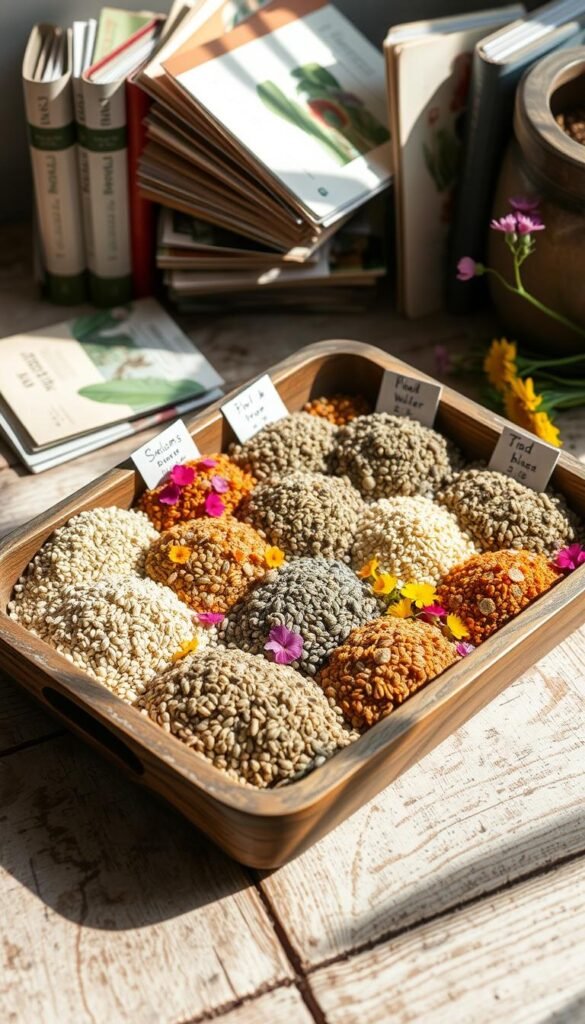
Choosing seed mixes is like picking the perfect ingredients for a recipe—quality matters more than quantity. Many pre-made options promise quick results but often include species unsuitable for your region. A mix labeled “Northeast Meadow,” for example, might contain aggressive growers that outcompete local varieties.
Matching Seed Mixes to Sun and Soil Conditions
Your success starts with understanding light patterns and earth composition. Full-sun areas need drought-tolerant seeds like purple coneflower, while shady spots thrive with woodland phlox. Test your soil pH before buying—most perennials prefer slightly acidic ground.
| Seed Mix Type | Cost Range | Key Features | Best For |
|---|---|---|---|
| Regional Blend | $25-$40/lb | 15+ native perennials | Long-term meadows |
| Budget Mix | $10-$20/lb | 50% grasses | Temporary displays |
| Custom Blend | $35-$60/lb | Tailored to your conditions | Specific chaos vs structure designs |
Invest in mixes with 12+ flowering species for staggered blooms. Avoid options where grasses dominate—they reduce nectar diversity. Reputable suppliers list exact percentages and origin details.
Remember: Annuals give one-season wonder, while perennials build lasting ecosystems. Your initial cost per pound might seem high, but established plants return yearly without reseeding. That’s smart gardening!
Wild Flower Garden Ideas: Mixing Native Species for Eco-Friendly Beauty
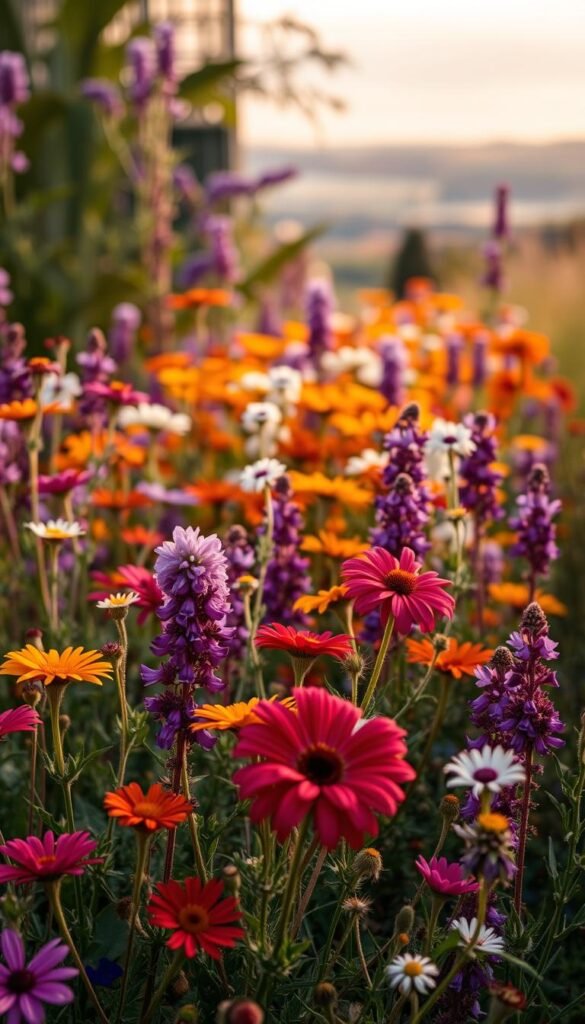
Creating a stunning outdoor space doesn’t require every color of the rainbow. A recent Virginia project proved that restricting your palette to cool tones—green, blue, purple, and white—can produce breathtaking results. The homeowner requested a pollinator haven using 70 carefully chosen species, all thriving in challenging site conditions.
Matrix planting became the secret weapon here. This method groups plants with complementary needs and staggered bloom times. You get continuous visual interest while supporting bees, butterflies, and birds year-round. The Virginia garden’s layered approach solved multiple problems: managing stormwater, creating privacy screens, and reducing maintenance.
| Color | Plant Name | Height | Ecological Role |
|---|---|---|---|
| Purple | Wild Lupine | 18-24″ | Hosts endangered butterflies |
| White | Mountain Mint | 36-48″ | Attracts predatory wasps |
| Blue | Virginia Bluebells | 12-18″ | Early spring nectar source |
Balance is key when combining species. Pair tall structural grasses with low-growing flowers to prevent overcrowding. Pro tip: Use silver-leafed varieties like Artemisia to make cool tones pop while deterring deer.
“The magic happens when you let plants perform double duty—beauty queens that also solve landscape issues.”
Your mix should address specific site challenges. Clay soil? Try swamp milkweed. Full sun? Purple coneflower thrives. By matching colors to your environment, you create living art that sustains ecosystems.
Designing a Pollinator-Friendly Native Garden
Your outdoor space becomes a lifeline when you intentionally support pollinators through thoughtful design. It’s not just about planting pretty flowers—it’s about crafting ecosystems where every element serves multiple purposes.
Building Homes for Winged Visitors
Think beyond blooms. Many butterflies need specific host plants for their larvae—milkweed for monarchs, parsley for swallowtails. Leave patches of bare ground for mining bees and small brush piles for mason bees. Did you know? 70% of native bees nest underground.
- Rotting logs become condos for solitary bees
- Leaf piles shelter overwintering insects
- Stone walls offer crevices for nesting
Strategic Planting for Constant Buffets
Group species in drifts of three or more to create visible targets. This approach helps pollinators conserve energy while feeding. Use this seasonal framework:
| Season | Plant Example | Butterfly Supported |
|---|---|---|
| Early Spring | Golden Alexanders | Black Swallowtail |
| Summer | Purple Coneflower | Fritillary |
| Fall | New England Aster | Monarch Migration |
For maximum impact, explore pollinator garden design strategies that pair bloom times with insect life cycles. Your garden becomes a year-round sanctuary when you mix early risers like wild columbine with late bloomers like joe-pye weed.
Establishing a Rain Garden with Indigenous Species
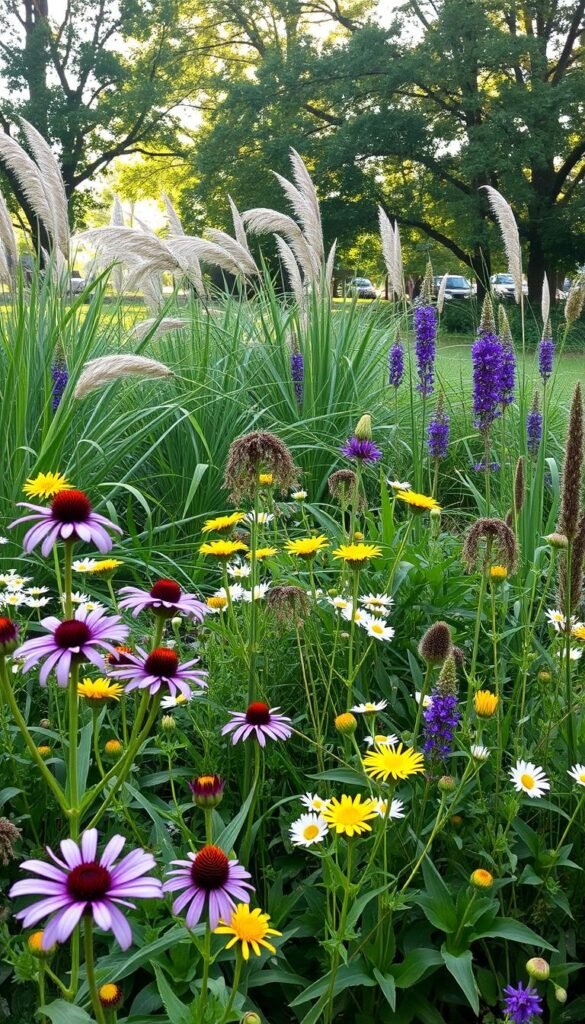
Turn stormwater challenges into ecological assets right in your backyard. Northern Virginia’s struggle with polluted runoff inspired a clever solution: shallow basins filled with water-loving plants that filter contaminants. By channeling roof drainage into a specially designed area, you create a living sponge that protects waterways while showcasing botanical beauty.
Strategic Placement Meets Natural Filtration
Position your rain garden 10 feet from buildings in a natural depression. Aim for a 6-8″ depth with sloping sides to manage water flow. This setup captures runoff while protecting foundations—critical in areas like the Chesapeake Bay watershed where 1 acre of pavement pollutes 16,000 gallons of rainwater annually.
| Plant | Height | Moisture Tolerance | Special Feature |
|---|---|---|---|
| Swamp Rose Mallow | 4-7 ft | Wet to damp | Filters heavy metals |
| Buttonbush | 6-12 ft | Flood-resistant | Butterfly magnet |
| Blue Flag Iris | 2-3 ft | Seasonal pools | Prevents soil erosion |
Mix tall grasses like soft-stem bulrush with flowering species for layered filtration. Their deep roots break up compacted earth, allowing water to percolate 2 inches per hour—key for mosquito prevention. Pro tip: Test drainage by digging a 12″ hole; if water remains after 48 hours, amend with sand.
“A well-designed rain garden handles 30% more stormwater than conventional lawns while supporting 8x more pollinators.”
Pair your rain garden with beginner-friendly flowers in adjacent dry zones. This creates transitional habitats and visual harmony. Remember: Healthy soil means less watering—these tough natives thrive on neglect once established!
Incorporating Native Grasses for Texture and Movement
The secret to year-round garden drama lies in the rustle of grass blades catching sunlight. These natural performers add depth to your landscape, shifting from emerald green in summer to fiery copper in autumn. Their slender forms create living screens that sway with every breeze, offering constant motion.
Seasonal Showstoppers With Purpose
Pair little bluestem with bold companions like rattlesnake master for striking contrasts. The grass’s blue-green stems offset the wildflower’s spiky white blooms, while both thrive in dry soil. Come winter, their dried seed heads become sculptural elements dusted with frost.
| Plant | Height | Seasonal Highlight | Ecological Role |
|---|---|---|---|
| ‘Standing Ovation’ little bluestem | 3-4 ft | Copper winter foliage | Songbird shelter |
| Feathery switchgrass | 5-6 ft | Snow-catching plumes | Butterfly host |
| Threadleaf bluestar | 2-3 ft | Golden fall color | Deer-resistant |
These plants work overtime across seasons. Mountain mint’s faded seed heads add texture beside winterberry’s crimson fruits. For elevating your space, combine vertical grasses with low-growing wildflowers—the height difference guides the eye upward.
Your winter scene transforms when ice crystals cling to grass stems. Unlike dormant flower beds, these structural elements maintain visual interest until spring’s return. Best part? They require zero cleanup, letting nature’s artistry shine.
Creating a Sustainable Wildflower Meadow
A thriving meadow starts with smart groundwork. Clear your chosen area thoroughly—remove aggressive weeds like thistle that compete with delicate wildflowers. This upfront effort saves time later by preventing invasive takeovers.
Choose a regional seed mix matching your soil type and sunlight. Scatter during fall or early winter so cold temperatures break dormancy naturally. Pro tip: Mix seeds with sand for even distribution. Patience is key—many perennials take 2-3 years to bloom fully.
Mow your meadow high (6-8 inches) during the first growing season. This controls weeds while letting young wildflowers establish roots. By year three, you’ll see a kaleidoscope of colors requiring minimal care.
Your living tapestry becomes a sanctuary for bees and butterflies. As the meadow matures, it stabilizes soil and resists drought. This low-maintenance approach lets nature handle the heavy lifting while you enjoy ever-changing beauty.

